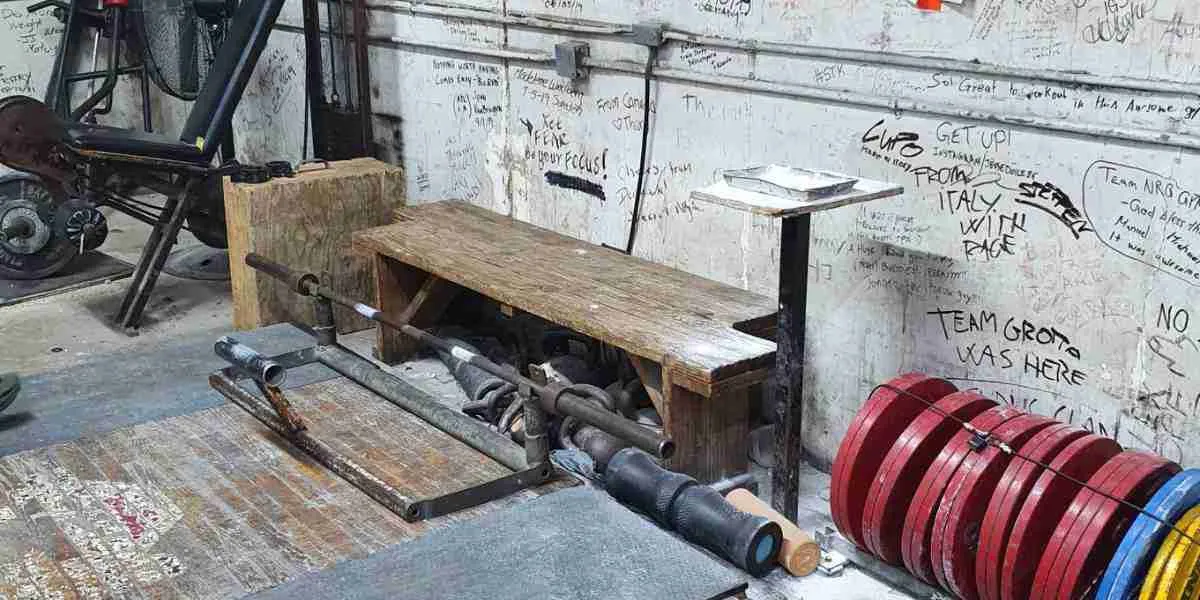- Read Time 5 Mins
German Volume Training
Imagine if there was a workout routine that could help you build muscle quickly, with limited time commitment? German Volume Training is that routine.
GVT - The Time Saving Muscle Hack
Sometimes you are going to find yourself in a gym with little more than a chest press, a leg extension or just one bit of kit to put a muscle under tension. Years ago I learned about the German Volume Training 10×10 method, and it’s been a lifesaver for me ever since. Time to share the advice on.

Author // David
Bothering dumbbells since 2003. I visit a lot of hotels with terrible gyms, so you don't have to. @theskinnyboy
To the point
- The German Volume Training workout method is a strength training system which can mean faster workouts
- In studies, German Volume Training showed a decrease in body fat and increase in strength
- German Volume Training features 10 sets of 10 reps at 50-60% of 1 RM

What Is German Volume Training?
German Volume Training, or GVT for short, is a weightlifting workout programme that was originally developed in Germany.
The programme involves performing 10 sets of 10 reps of a given weightlifting exercise. This might sound like a lot, but because you’re only lifting a moderate weight, it’s actually doable for most people.
GVT is based on the philosophy that if you want to make muscle gains, you need to work your muscles to failure. And by doing 10 sets of 10 reps, you’re really putting your muscles under a lot of stress and forcing them to grow.
Which Bodybuilders Used GVT?
Amongst the first bodybuilders to make German Volume Training known, was not a German but a Canadian, Quebecer Charles Poliquin in the 1970s. Charles was a Canadian strength coach who applied the 10×10 principle to his professiona athletes, including Olympic Gold medallists.
Vince Gironda a notable bodybuilder, Bev Francis, Rolf Feser, Jacques Demers and Arnold Schwarzenegger have all discussed following this type of training program to pack on lean body mass.
What Is The Science Behind GVT (10x10)
A study published in the Journal of Strength and Conditioning Research found that subjects who performed GVT workouts twice a week for six weeks saw a significant increase in muscle mass and strength.
Source: Effects of 12-Week Modified GVT Program on Muscle Strength and Hypertrophy
How Does German Volume Training Work?
The goal of German Volume Training is to overload the muscles with a high volume of work. The program is based on the principle of performing 10 sets of 10 repetitions of a given exercise, with a rest period of 60 seconds between sets. The idea behind this approach is that with a high volume of work, the muscles will be forced to adapt and grow in size and strength.
The program is designed to target a specific muscle group, and the exercises are typically compound movements that involve multiple muscle groups. For example, squats, deadlifts, and bench press are popular exercises that are used in GVT. The weight used for GVT should be relatively light, and the focus should be on performing the exercises with perfect form and using the appropriate tempo.
Principles of German Volume Training

GVT is based on three main principles: Overload, Specialization, and Progression.
Overload Principle
The overload principle states that the muscles must be overloaded with a high volume of work in order to stimulate growth. This means that the exercises must be performed with a heavy weight, and the number of repetitions should be kept high. A German Volume Training workout for this reason keeps the suggested weight used for the 10 sets of 10, to around 60% of your 1RM. Don’t be afraid to start your first set a touch lighter and as you near the end of the 10 sets, you may struggle to complete 10 full reps.
Specialisation Principle
The specialization principle states that the exercises should be focused on one muscle group. This means that the exercises should be chosen carefully, and the program should be tailored to the individual’s goals. As a general rule, you would opt for a compound lift, one built around a foundational move. So bench presses, or incline dumbbell press as opposed to a pec flye, or shoulder press rather than lateral raise.
Progression Principle
The progression principle states that the program should be progressive, meaning that the intensity and volume should be increased as the muscles adapt. This can be done by increasing the weight, decreasing the rest periods, or increasing the number of sets and repetitions.
What weight for German Volume Training?
When performing GVT, the weight used should be relatively light. The focus should be on performing the exercises with perfect form and using the appropriate tempo. The weight should be light enough that you can perform 10 sets of 10 repetitions with good form, but heavy enough to challenge the muscles. As you get stronger and your muscles adapt to the volume of work, you can gradually increase the weight.
What Rest Intervals For GVT
The rest intervals for GVT should be kept to 60 seconds between sets. This is done to ensure that the muscles are challenged and forced to work harder and longer, leading to greater gains in muscle mass and strength. Additionally, the short rest periods will help to increase metabolic stress, which can lead to increased fat loss.
How Often – GVT Training Frequency
GVT is typically done two to three times per week, with each workout focusing on a different muscle group. For example, you can do chest and back on Monday, arms and shoulders on Wednesday, and legs on Friday. It is important to give the muscles time to recover in between workouts, so it is important to make sure that you are not overtraining.
While you can focus strictly on a German Volume Training Program, you can also use the training system as a way to supplement another training plan. I write this article having put 10 sets of 10 flat bench into my push day on a 5 Day Push Pull Legs Split. Likewise on the recent Legs day, I brought 10×10 of front barbell squat in. Both times was down to lack of time in my calendar, so I needed a shortcut, but having done a lot of heavy compound lifts recently, it was nice to change things up also. 3 days after that leg workout, I have lovely muscle soreness – so it definitely shocked the system. It’s perhaps for this reason why it’s so often used in Strength Training Circles and by the late great Charles Poliquin for smashing through strength plateaus and putting muscle groups on growth mode.

Benefits of German Volume Training (GVT)
- Time Saver
- Low Equipment Needs
Stuck in a hotel gym in London with no Squat rack? It’s cool, do 10 sets of 10 leg curl, then do the same with leg extension; finish up with jumping squats to failure, then wobble back to your hotel room.
It’s a great way to break through training plateaus.
It can improve your strength endurance – which means you’ll be able to lift heavier weights for longer periods of time.
It can help reduce body fat levels.
Exercises For German Volume Training
The best exercises for GVT are compound movements that involve multiple muscle groups. Examples of these exercises include squats, deadlifts, bench press, barbell rows, overhead press, and chin-ups. These exercises are great for targeting a specific muscle group and for overloading the muscles with a high volume of work. Additionally, these exercises are great for developing strength, power, and muscular endurance.
Best GVT Exercise For Chest
The best GVT exercise for the chest is the bench press. This exercise is a great compound movement that works multiple muscle groups, including the chest, shoulders, and triceps. Additionally, the bench press is a great way to overload the chest muscles with a high volume of work. The weight should be relatively light, and the focus should be on performing the exercise with perfect form and using the appropriate tempo. You can read our GVT chest guide here.
Best GVT Exercise For Back
The best GVT exercise for the back is the bent-over barbell row. This exercise is a great compound movement that works multiple muscle groups, including the back, biceps, and shoulders. Additionally, the bent-over barbell row is a great way to overload the back muscles with a high volume of work. The weight should be relatively light, and the focus should be on performing the exercise with perfect form and using the appropriate tempo.
Next: Read our GVT Back Workout guide.
Best GVT Exercise For Shoulders
The best GVT exercise for the shoulders is the overhead press. This exercise is a great compound movement that works multiple muscle groups, including the shoulders, triceps, and core. Additionally, the overhead press is a great way to overload the shoulder muscles with a high volume of work. The weight should be relatively light, and the focus should be on performing the exercise with perfect form and using the appropriate tempo.
Best GVT Exercise For Legs
The best GVT exercise for the legs is the squat. This exercise is a great compound movement that works multiple muscle groups, including the quadriceps, hamstrings, and glutes. Additionally, the squat is a great way to overload the leg muscles with a high volume of work. The weight should be relatively light, and the focus should be on performing the exercise with perfect form and using the appropriate tempo.
Sample German Volume Training Workout
Here is a sample GVT workout for the chest:
Machine Chest Press – Warm-up sets 2-3 x 12-15
Barbell Bench Press – 10 sets x 10 reps @60-70% of 10 rep max.
Cable Crossovers – 3 sets x 12 reps – 1 set of 25 reps at 12 rep weight
Rest periods should be kept to 60 seconds between sets. The weight used should be lighter than your best ’10 repper’, and the focus should be on performing the exercises with perfect form and using the appropriate tempo.
Aim for 2 to 3 second lower, 1 second up. As you can see, a workout like this seems pretty short and sweet. It makes it perfect for a ‘de-load’ period, coming off of heavy weights and done at maximal intensity, you will feel it in the DOMS the next day. In and out in under 30-40 minutes. Perfect for a lunch break.
Want an arms version instead? Try this next: GVT Arm Day
Common GVT FAQs
Will 10 x 10 Rep Set Range Build Muscle?
Yes, the 10 x 10 rep set range is an effective way to build muscle. The idea behind this 10 sets approach is that with a high volume of work, the muscles will be forced to adapt and grow in size and strength. This is achieved by forcing the muscles to move heavier loads than they are accustomed to, which stimulates muscle growth. Additionally, the short rest periods between sets forces the muscles to work harder and longer, leading to greater gains in muscle mass and strength – aka ‘Growth Mode’.
Can I Do Cardio With German Volume Training?
Yes, you can do cardio with GVT. However, it is important to note that GVT is a high-volume program, and the focus should be on performing the exercises with perfect form and using the appropriate tempo. Therefore, it is not recommended to do cardio during GVT workouts, as this may decrease the intensity of the workouts. Additionally, it is important to make sure that you are giving your muscles enough time to rest and recover between workouts.
Is GVT Good For Fat Loss?
Yes, GVT can be a good option for fat loss. As mentioned earlier, GVT is a high-volume program, and the short rest periods between sets forces the muscles to work harder and longer, leading to increased metabolic stress. This can lead to increased fat loss. Additionally, GVT can help to increase muscular endurance, which can lead to improved performance during other forms of cardio.
If you want to see this in action, hit Quads and Glutes the same session, with a GVT Superset. I would do this during l*ckdown to keep ticking over and fight off the weight gain.
10 x 10 for Squats, 10 x 10 for deadlifts. Hit one set of each before resting for 90 seconds and repeating 10 times.
Finish up by trying to remember what dry clothes felt like.
Outro // The wrap up
So, if you’re looking for an efficient way to pack on muscle without spending hours in the gym, German Volume Training can be a solid option. Just be sure to focus on progressive overload and keep track of your reps and weight so you can make continual gains. I use a little notepad app on my phone, a cheap diary works well too. (Don’t sleep on the value of recording your lifts!) Finally, always consult with a doctor or fitness professional before starting any new workout routine, if you’re new to the gym or been out for a while.
Remember – German Volume Training GVT is a sets and reps training system, more than it is a workout program. Which means it works great for being brought into a low weight high rep volume training program or as a way of moving from winter strength training to summer hypertrophy. For me, I use it as a substitute when time is short, or if I am on holiday and the fitness options are limited. 10 x 10 at 60% of your 1 rep max sat on a chest press is doable at nearly every resort fitness centre at least.